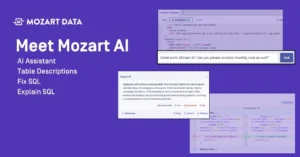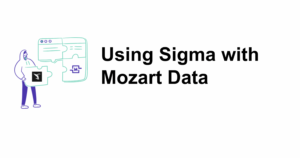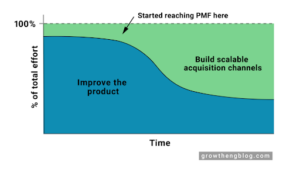When you get started with analytics, you should always focus on two things:
-
Simplicity
-
Connectivity
Your goal should be to find the fastest path to make better decisions using the data you have.
Simplicity
First of all, you need a manageable way of getting started.
Today’s modern data stack is overwhelming. You could sign up for 20 different tools, spend hundreds of thousands of dollars, and then be stuck trying to integrate your integration tools.
For the largest enterprises, this might make sense. But for most companies, it’s a waste of time, it’s a waste of money, and it distracts you from the goal – making data-driven decisions.
Better decision making should be your focus from day 1, and it should be your north star as you develop your data capabilities over time.
What does a simple solution look like?
A single interface that combines the moving pieces necessary for turning data into insights.
-
Data integrations to your databases and business applications
-
A processing environment (i.e. a data warehouse)
-
Transformation capabilities to turn raw data into insights
-
A clear path to visualize and share insights with internal stakeholders
Over time, there are other pieces to consider – data quality, operationalizing data back into business applications, etc. – but when you get started, your entire focus should be on insights.
This allows your team to spend time on the things that matter.
Which KPIs should you look at every day? Which metrics tell your COO how to more effectively allocate resources? How do you improve the customer experience?
Keep your tech stack simple, and focus your time generating high value insights.
Connectivity
Simple solutions are great, but if you can’t connect to the data sources that are in place across your particular company, you need to look elsewhere.
Before getting started with any sort of a modern data stack, you should identify the core data sources within your enterprise.
They typically fall into three categories:
-
Databases that power your product
-
3rd party applications used across your organization (CRM system, ticketing system, etc.)
-
Behavioral events that are collected from your website and mobile app
Meet with your product and engineering teams to identify core databases. Are they Postgres databases? SQL server? MySQL?
Talk to your IT department to identify which 3rd party applications are in use by your company. Organize the applications by business function and prioritize which applications are most important to powering strategic decisions.
Then speak with your product, engineering, and marketing teams about the data being collected from your website (public marketing site, and your product) and any event data collected from your mobile app (if applicable).
Organize this list of critical business systems before you talk to any partners about standing up your modern data stack.
If your most important data sources are webinar tools, you’re going to have to find a solution with connectivity to webinar tools.
If you make decisions based on subscription billing data. Find a vendor that can support your subscription billing tool.
Find providers that support your needs today as well as into the future.
Focus on insights, not infrastructure
Prioritize the questions you want to answer with data, identify the tools in your organization with the information to power those insights, and find the simplest solution to turn data into insights.
Mozart Data has the simplest modern data stack solution on the market.
And now clients of Mozart Data can now tap into Portable’s 200+ data sources and unparalleled development speed.
We’re ready to get to work building the connectors you need.
Visit http://portable.io/ to learn more about Portable’s no-code connectors and development capabilities.


